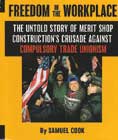 |
The Architecture of Tilt-Up Manual
1st Edition released by The Tilt-Up Concrete Association
ISBN: 0-9678499-8-5;130 pages; $145.00
This manual is the second part of a trilogy of resources on the design and construction of site-cast Tilt-Up construction, a construction method in which concrete wall panels are cast on site and tilted into place. The content of this manual was developed by TCA with the guidance of leading design professionals with vast experience in the building method, as well as feedback received during recent design charettes hosted by the association. A general overview of the construction process is provided, as well as information to help designers capitalize on the economy and efficiency the construction medium offers while also serving as a solution for complex design vernaculars. The Architecture of Tilt-Up consists of more than 130 pages of full-color, detailed photography and corresponding information, from the initial concept of selecting Tilt-Up through a variety of building types, finish options and design fea- tures. The manual concludes with appendices that provide guidelines specifications, common detailing solutions and theories, as well as a directory of current product suppliers.
![]()
![]()
 |
The Handbook of Highway Engineering
Edited by Tien Fang Fwa, Taylor & FrancisBooks Inc./CRC Press, 800 pages
This book explores the expanded responsibilities of modern highway engineers, as well as the increasing trend toward privatization of project development and financing. It starts with project financing, site access management, environmental impact, road safety and noise. The next section considers technical issues in highway and pavement engineering, including materials, new mechanistic-empirical design approaches, and new closed-form solutions for back calculation and deflection and stress computation in multi-slab systems used in new highway projects.
![]()
 |
4th Edition, edited by Cyril M. Harris, McGraw-Hill, 2005,
1,089 pages
![]()
 |
Winning Hearts
The Battle for the 'Merit Shop'
In 1950, there was almost a declaration of war between competing labor philosophies in construction with the formation of the Associated Builders and Contractors in Baltimore. The first seven members were nonunion contractors in a market 90% controlled by building trade unions. Against a backdrop of threats, intimidation and violence, the firms believed that the time had come for project owners to select contractors on the merits of their capabilities and price rather than union affiliation. That battle continues today, but the marketplace will never be the same, says Samuel Cook, former ABC general counsel and author of Freedom in the Workplace, (Regnery Publishing Co., Washington, D.C., ISBN 0-89526-035-2, 839 pages, $35). By launching this 'merit shop'movement, the Baltimore contractors put in motion a machine that would become one of the nation's largest trade associations. They also set the stage for half a century of legal, political and economic battles against compulsory unionism, autocratic control of the industry and other union abuses. Says Cook, "Broken bones, torn bodies, death threats, arson and the destruction of property are not differences of opinion."

Post a comment to this article
Report Abusive Comment